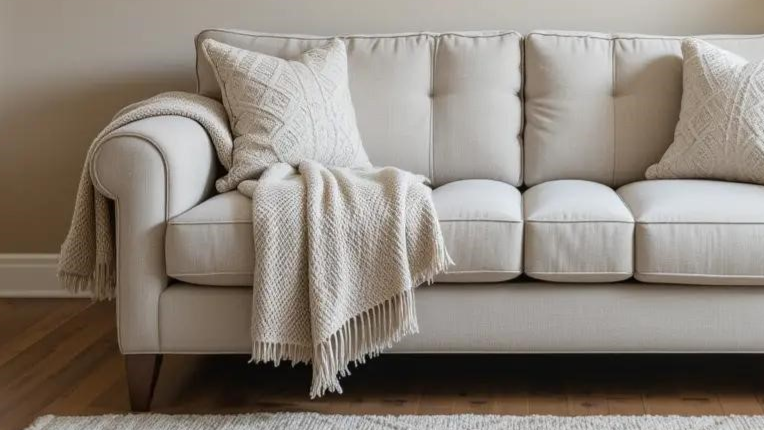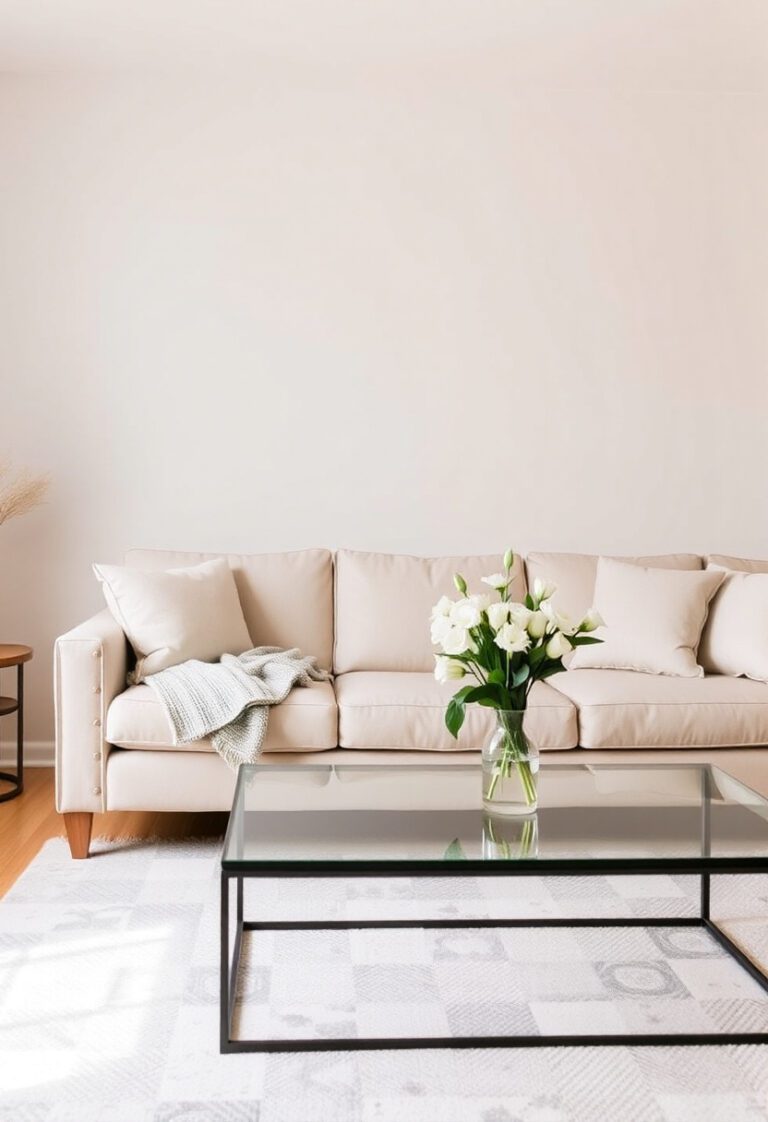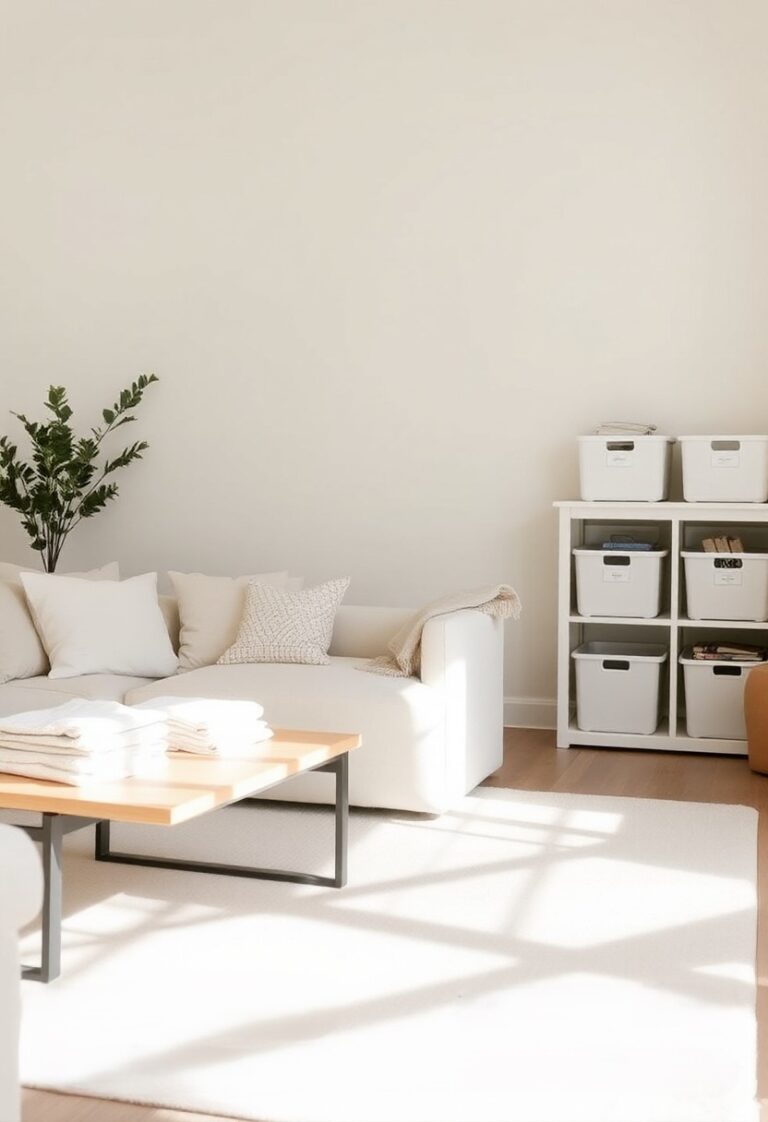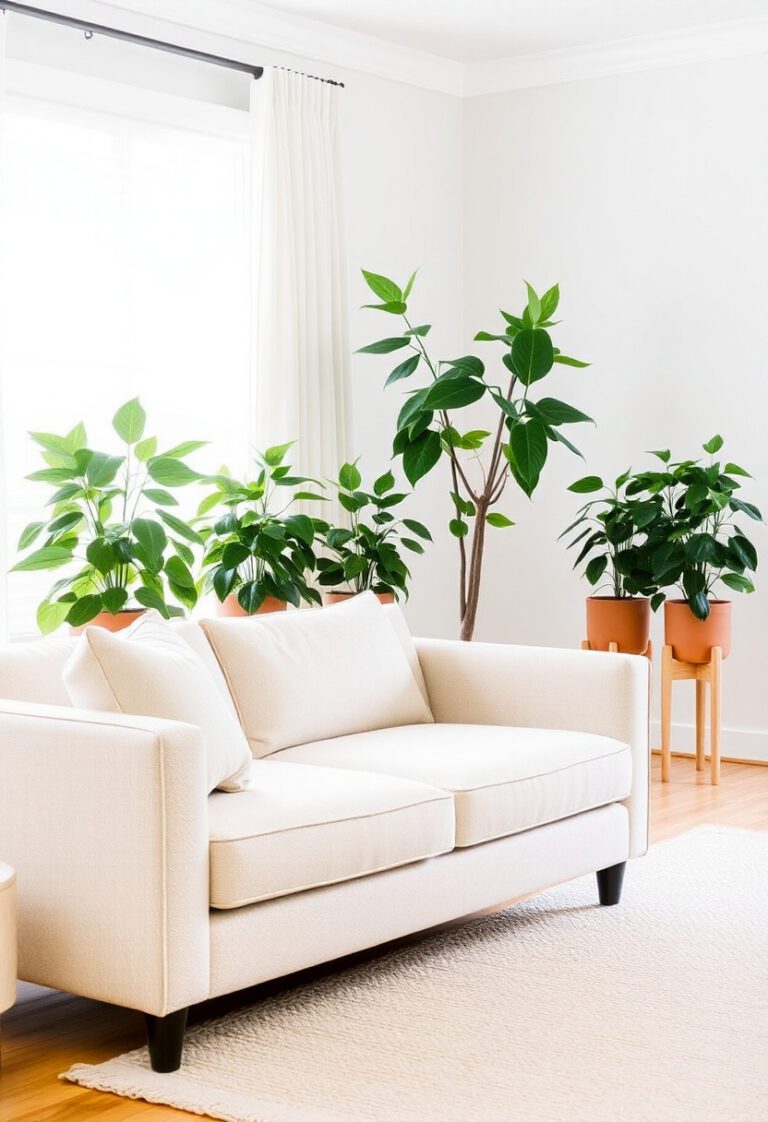Feeling overwhelmed by visual clutter and mess? These 8 quick living room reset tasks will help you reclaim your space and create a calm, inviting atmosphere. Whether you’re doing a nightly reset or weekend refresh, these simple steps will guide you to a tidy, grounded living room that feels good to walk into.
A cluttered living room can drain your energy and make relaxation feel impossible. But with the right approach, transforming your space doesn’t require hours of deep cleaning or expensive renovations. These living room reset tasks focus on simple, actionable steps that create immediate impact. When you establish consistent habits around these reset routines, you’ll find your living room becomes a place where you actually want to spend time.
The beauty of a home reset routine lies in its simplicity. Each task builds on the next, creating a systematic approach that works whether you have 10 minutes or an hour. Let’s dive into these proven strategies that will help you reset your living room into the peaceful retreat you deserve.
1. Clear All Surfaces
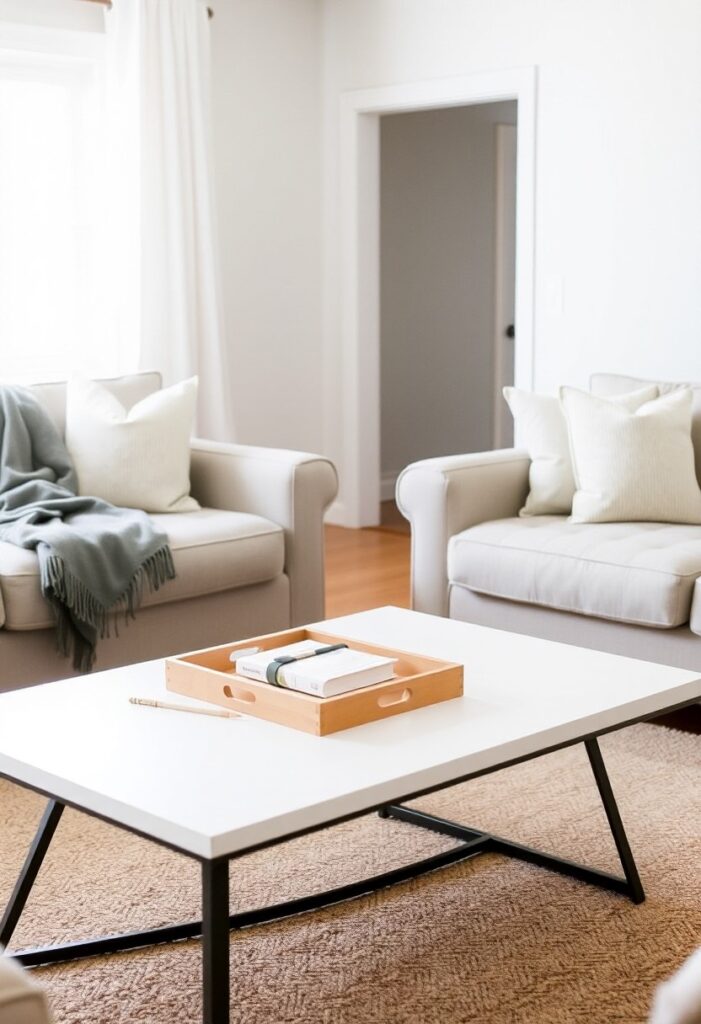
Start with the most visible areas first. Coffee tables, consoles, and side tables tend to collect the most clutter throughout the day. Mail, empty mugs, remote controls, and random items seem to gravitate toward these surfaces, creating visual chaos that impacts your mental state.
Begin by removing everything from these surfaces. Don’t worry about organizing yet – just clear them completely. Wipe down each surface with a microfiber cloth or appropriate cleaner. This simple act of clearing and cleaning creates an immediate sense of accomplishment and sets the tone for the rest of your reset.
Return items to their designated homes. Mail goes to your inbox or filing system, mugs return to the kitchen, and electronics get properly stored. This is one of the most effective living room clutter solutions because it addresses the root cause of surface mess.
2. Fluff the Pillows and Fold the Throws
Your seating area is the focal point of most living rooms, so giving it attention makes a disproportionate impact. Fluffing pillows and folding throws properly transforms your couch from looking lived-in to looking intentional.
Remove all pillows and give them a good shake to restore their shape. If your pillows have lost their fluff over time, a quick tumble in the dryer on low heat with a couple of tennis balls can help restore their volume. Arrange them according to your preferred style – whether that’s symmetrical, asymmetrical, or a mix of sizes and textures.
Fold throws neatly and drape them over the back or arm of your couch. This creates clean lines and makes the seating area look more polished. A well-styled couch anchors the entire room and contributes significantly to those calm living room ideas you’re seeking.
Essential Living Room Reset Tasks for Daily Maintenance
Quick declutter tasks become second nature when you approach them systematically. The key is focusing on high-impact areas that create the most visual improvement with minimal effort.
3. Pick Up Floor Clutter
Floors are magnets for items that don’t have a designated home. Shoes by the door, children’s toys, charging cords, bags, and books all tend to end up on the floor throughout the day. Clearing floor clutter immediately makes your room feel larger and more organized.
Work methodically from one side of the room to the other. Pick up items and either put them in their proper place or create a temporary “staging area” if you need to deal with them later. Pay special attention to areas around furniture where items tend to accumulate.
Don’t forget about items that might be hiding under coffee tables or behind furniture. These forgotten items contribute to the overall feeling of disorder even if they’re not immediately visible.
4. Reset the Lighting
Lighting has tremendous power to shift the space. Harsh overhead lighting can make even the cleanest room feel sterile and unwelcoming. As part of your evening reset routine, transition to softer, warmer lighting options.
Turn off bright overhead lights and instead use table lamps or floor lamps to create a more intimate atmosphere.
Consider the color temperature of your bulbs. Warm white (2700K-3000K) creates a cozy, relaxing atmosphere that’s perfect for unwinding. Cool white lights are better for task-oriented activities but can feel harsh during relaxation time.
5. Quick Vacuum or Sweep
Even just 2 minutes of floor cleaning makes a significant difference in how your space feels. You don’t need to move furniture or do a deep clean – focus on the main walkways and visible floor areas.
If you have hardwood or tile floors, a quick sweep or dry mop will remove dust and debris. For carpeted areas, run the vacuum over high-traffic zones. This simple step removes the gritty feeling underfoot and creates a fresh foundation for your newly organized space.
The psychological impact of clean floors shouldn’t be underestimated. Walking on clean surfaces signals to your brain that the space is cared for and ready for relaxation.
6. Style the Coffee Table
A thoughtfully styled coffee table serves as the room’s centerpiece and demonstrates that your space is intentional rather than chaotic. The key is finding the balance between functional and beautiful.
Start with a tray as your foundation – this creates boundaries and makes styling easier. Add one or two books (coffee table books work well) or a small plant. The rule of three works well here: choose three different heights and textures for visual interest.
Remove excess items that don’t serve a purpose. Your coffee table should feel curated, not cluttered. Keep only items that you actually use or that bring you joy when you see them.
7. Diffuse a Calming Scent
Scent has a direct pathway to the brain and can instantly shift your mood and perception of a space. Adding a pleasant, calming fragrance is one of the most effective ways to complete your living room transformation.
Essential oils like lavender, eucalyptus, or cedar create a grounding atmosphere that supports relaxation. Use a diffuser for consistent scent distribution. Avoid overwhelming scents – subtlety is key.
If you’re sensitive to scents or prefer fragrance-free spaces, focus on removing any unpleasant odors by ensuring good ventilation and addressing the source of any mustiness or staleness.
8. Take a Final Pause
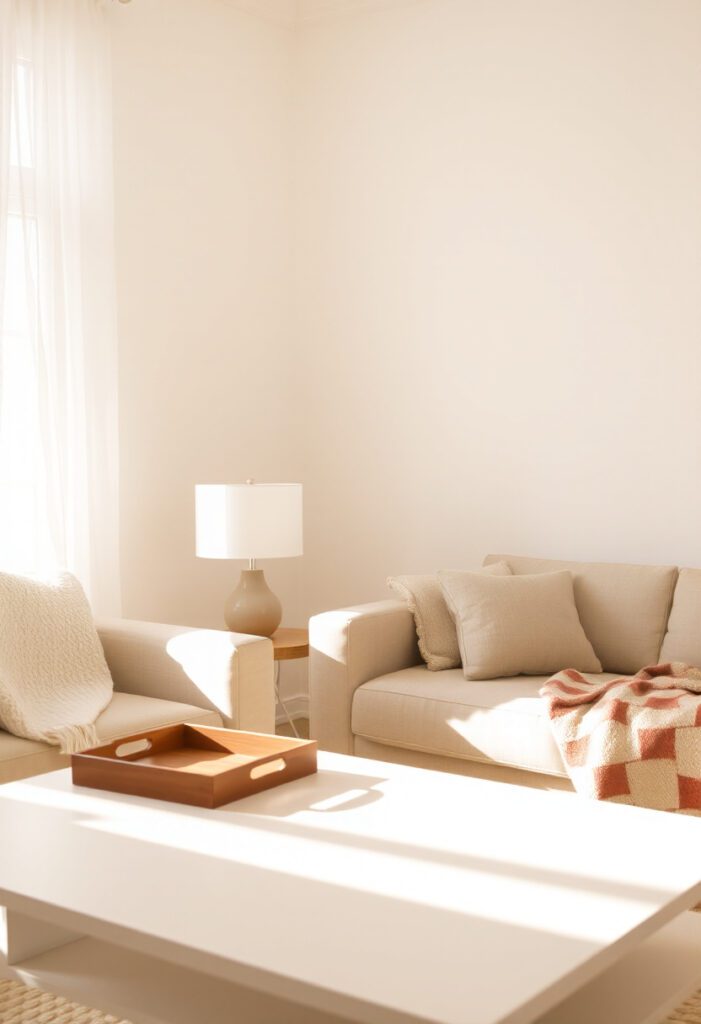
The last reset task isn’t about doing more — it’s about stepping back and observing. Pause for a moment and just look around your living room. Don’t rush to judge or fix anything — just notice.
Is there anything still visually overwhelming? Is a certain corner feeling too heavy?
This moment of pause helps your brain shift gears — from task mode to awareness mode. It’s not about celebrating a perfect space, but checking in with how the room actually feels. This helps you stay attuned to what your space really needs — not just today, but over time.
Making Living Room Organization a Sustainable Habit
Consistency is more important than perfection when it comes to living room organization. These reset tasks work best when they become part of your regular routine rather than occasional deep-cleaning sessions.
Consider timing your resets strategically. Many people find success with a 10-minute reset each evening before bed, while others prefer a more thorough weekend refresh. Find what works for your schedule and stick with it.
Remember that maintenance is easier than restoration. When you consistently complete these living room reset tasks, you’ll find that each session becomes quicker and more efficient. Your living room will maintain its calm, organized state with minimal effort.
The goal isn’t to create a showroom – it’s to create a space that supports your well-being and makes you feel peaceful when you walk into it. These simple tasks, when done regularly, create the foundation for the calm, organized living room you’ve been wanting.
For more living room ideas, check out 14 Cozy Living Room Ideas That Feel Warm and Welcoming.
Frequently Asked Questions
How often should I complete these living room reset tasks? For best results, complete a quick 10-15 minute reset daily, focusing on clearing surfaces and picking up clutter. Do a more thorough reset including vacuuming and styling once or twice per week. The frequency depends on how much you use the space and your household size.
What if I don’t have time for all 8 tasks every day? Start with the first three tasks: clearing surfaces, fluffing pillows, and picking up floor clutter. These have the biggest visual impact and can be done in under 10 minutes. Add the other tasks as time permits or rotate through them on different days.
How do I prevent clutter from accumulating so quickly? Create designated homes for common items like remote controls, magazines, and charging cords. Use baskets or trays to contain items that tend to migrate.
What should I do with items that don’t belong in the living room? Create a “migration basket” for items that need to be returned to other rooms. During your reset, quickly walk through the house and return these items to their proper locations. This prevents the living room from becoming a dumping ground for the entire house.
How can I get my family members to help with the reset routine? Make it a family activity by assigning each person specific tasks based on their age and ability. Set a timer for 10 minutes and make it a game. Lead by example and praise their efforts.
What if my living room is too small for all these steps? Adapt the tasks to your space. Focus on the steps that have the most impact in your specific layout. Even in small spaces, clearing surfaces and managing lighting can make a significant difference. Scale the tasks to match your room size and storage capabilities.

